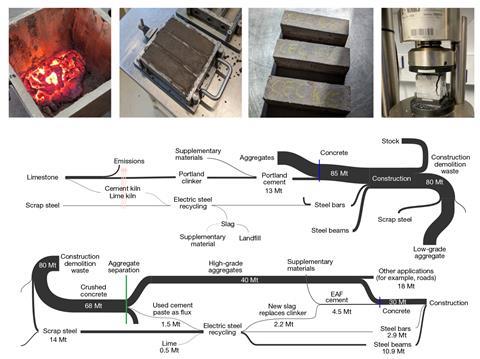‘Zero-carbon’ cement made by feeding concrete construction waste into existing steel recycling processes could potentially slash carbon emissions for both cement and steel industries. The approach is the ‘first cement recycling method proposed to date’, according to the team, and could offer a solution to one of the world’s most pressing decarbonisation challenges.

Estimates suggest around 7.5% of current anthropogenic carbon dioxide emissions derive from cement production. Meanwhile, steel production is thought to contribute to at least 6%. Driving these emissions is dependence on lime to make these materials.
Portland cement requires clinker, which is made by heating limestone and minerals in a kiln. This releases carbon dioxide from the limestone (calcium carbonate) when it is converted to lime (calcium oxide). Clinker is then combined with silica-rich clays in a furnace to make cement. Meanwhile, steel production requires lime as a flux material to mop-up impurities from the molten metal during the manufacturing process.
Now, Julian Allwood’s group at the University of Cambridge, UK, has developed a process that recycles cement from waste demolition concrete – which comprises cement, sand, aggregates and water – by using it as a lime supplement to remove impurities in steel recycling. The upshot is that cement is re-clinkered in the process, enabling it to be reused in new concrete, while less lime is needed to recycle steel.
‘We had noted that steel decarbonation was possible because steel recycling was well established, but that the emissions associated to the lime flux seemed to present an insurmountable problem,’ explains Cyrille Dunant, who helped develop the new process. ‘It then occurred to me that cement paste could replace the flux.’
Cementing electricity’s place
In the new process, old cement powder is first extracted from waste concrete, either mechanically or by heating. This old cement is then fed into the recycling process for scrap steel, which uses an electric arc furnace to melt the material. The cement then becomes a flux to soak up impurities, which then forms a liquid slag that floats on the surface of the liquid steel. Once the molten steel is removed, the slag rapidly cools in air and is ground up into a powder.
Pilot-scale trials by the researchers’ start-up company, Cambridge Electric Cement, has demonstrated this combined recycling process, revealing that the recycled cement slag has a near-identical chemical composition to conventional clinker.

‘This is a really interesting development, with great potential,’ comments Leon Black, an expert in infrastructure materials at the University of Leeds, UK. ‘The group has been able to overcome a major barrier to the development of new cements in that they have stuck with Portland cement, but just found a more efficient way of producing it.’
Dunant explains that the recycled cement could potentially be zero carbon because the emissions have already occurred through the decarbonation of lime when it was originally made. ‘Recycling the cement only has the emissions associated with the heat and it’s electric,’ he says. ‘Crucially, as this can substitute part of the lime used in steel recycling, the combined emissions of recycling steel and cement together can be lower than only recycling steel, depending on the grade of scrap.’
However, Black notes some challenges. ‘A big problem is going to be sourcing sufficient quantities of concrete waste. This is what has stopped the cement industry doing it with their process,’ he says. ‘The other issue is the temperature needed to produce the cement. This is much higher than used in a cement kiln, so the complete decarbonisation of the production process is going to be dependent on decarbonising electricity generation.’
The researchers are confident these challenges can be overcome but recognise further work is needed. ‘We need to understand how to modify the operations of existing large scale industrial equipment … to make it produce cement – which it was not designed to do,’ he says. ‘We also need to qualify the new clinker for durability and for consistency of the production quality.’
The researchers have filed a patent on the process and are now working on industrial trials with construction industry partners. They predict the process could be producing 1 billion tonnes of cement per year by 2050, which represents roughly a quarter of current annual cement production. ‘We hope that it will grow to cover a significant fraction of the cement needs, lowering the impact of this absolutely crucial material,’ adds Dunant.
References
CF Dunant et al, Nature, 2024, DOI: 10.1038/s41586-024-07338-8












No comments yet